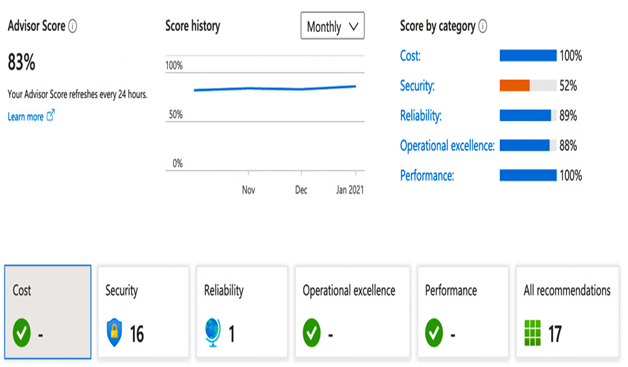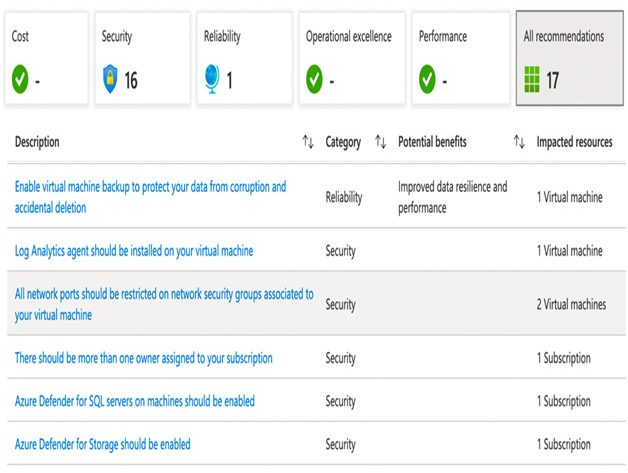Categories
Archives
- September 2024
- August 2024
- July 2024
- June 2024
- April 2024
- March 2024
- January 2024
- December 2023
- October 2023
- September 2023
- August 2023
- July 2023
- May 2023
- April 2023
- February 2023
- January 2023
- November 2022
- October 2022
- September 2022
- July 2022
- May 2022
- April 2022
- February 2022
- January 2022
- December 2021
- November 2021
- September 2021
- August 2021
- July 2021
Perhaps the most useful tool, Azure Advisor makes suggestions for you based on your services’ many different aspects.
Categorized by cost, security, reliability, operational excellence, and performance, you can quickly see a series of opportunities to optimize your service. Some of these recommendations include cost and performance options. As we discussed earlier, however, Azure Advisor performs this analysis automatically and continually.
The following screenshot shows an example Advisor overview page:

Figure 10.8 – Azure Advisor overview page
By clicking on a heading, you can drill down into each recommendation. Next, click on the recommendation itself, and you are given detailed information, and in some cases can click through wizards, to implement the suggestions.
As we can see in the following screenshot, recommendations are easy to view and show you how many resources they affect:

Figure 10.9 – Azure Advisor recommendation details
Through automated tools and your investigations, you can optimize your environment and ensure your services are running efficiently and reliably over time.
Summary
In this chapter, we have examined how to build a strategy for migrating workloads into Azure. We looked at the types of issues you must consider and the available tools for collating and documenting an as-is environment.
We then looked at what tools are available to perform VM and database migrations, including the different options available. Finally, we investigated the need to monitor and optimize post-migration, again looking at the other tools available to achieve this.
In the next chapter, we begin Section 4, Applications and Databases, and we start by comparing the different types of application components to choose from when building modern, cloud-native solutions.
Exam scenario
The solutions to the exam scenarios can be found on the Assessments page at the end of the book.
MegaCorp Inc. currently leases space in a third-party data center, but their current contract is coming to an end in 6 months. They have decided to migrate some of their workloads to Azure to reduce costs. However, any move must be completed before the contract end date.
Much of their server estate consists of web applications running on Windows Server 2018 with Internet Information Services server installed, file servers, and Windows SQL servers.
Some websites run on web server farms – multiple web servers built as load-balanced clusters running various websites.
Most of the SQL servers are running standard databases, but they are concerned some older databases may be using outdated features and procedures.
Develop a migration strategy, suggestion tooling, and highlight any potential issues they might encounter.

Leave a Reply